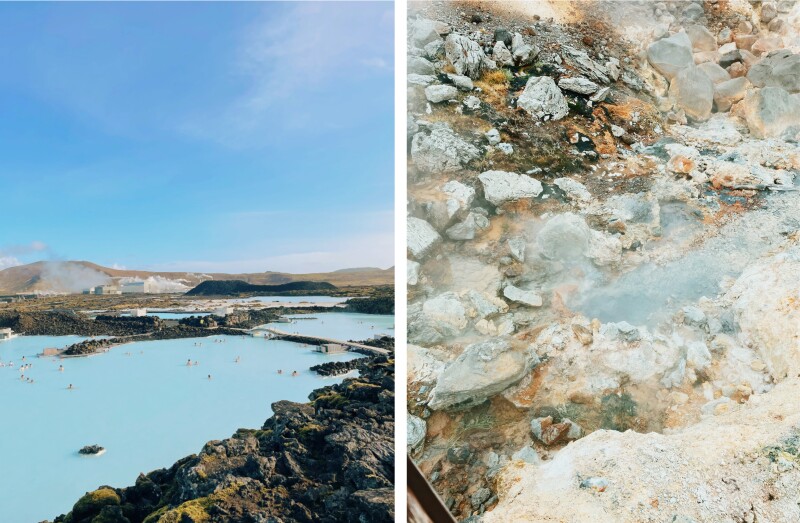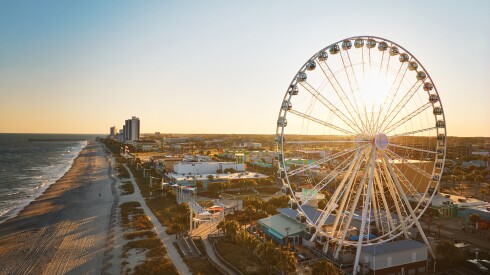With its abundance of natural wonders, including giant volcanic craters, black-sand beaches, and a seemingly never-ending supply of waterfalls, Iceland is the location for travelers who love the outdoors. While the country’s peak tourism season falls between June and August, there’s fun to be had throughout the year. I visited the country in late March and enjoyed scenic drives to waterfalls, dips in steamy lagoons, and chilly nights watching the Northern Lights illuminate the sky. To help you prepare for (or simply daydream about) your next visit, here’s a list of the best things to do in Iceland all year long.
Year-round activities in Iceland

Iceland’s Blue Lagoon, a geothermal spa close to Reykjavik, is a must for first time visitors to Iceland.
Photos by Michelle Heimerman
Soak in a hot spring
The country’s plentiful hot springs remain a toasty 100°F even as the air outside gets colder. The Blue Lagoon, a geothermal spa, hotel, and restaurant, is a common stop for travelers heading to and from Keflavík Airport. It’s renowned for its distinctive blue waters (the result of light reflected off silica in the water), and silica mud masks. Another option is Sky Lagoon, located in Reykjavík, which offers visitors a chance to go through its seven-step ritual, involving an ice bath, sauna, cold mist, body scrub, and more. I spent several hours at both the Blue Lagoon and Sky Lagoon during my visit, donning face masks and enjoying both body treatments and cocktails.
Visit a “nature museum unlike any other”
If the weather isn’t on your side during your visit, there are many indoor activities to enjoy. Located a 10-minute drive from Reykjavík, Perlan is a visitor center that offers travelers the opportunity to experience the best of Iceland’s natural wonders—ice caves, glaciers, volcano eruptions, seabird cliffs, and the Northern Lights—via a planetarium, a walk-through indoor ice cave, and other indoor exhibitions.
Go shopping in Reykajvík
Though I spent many of my days in Iceland road-tripping, I used Reykjavík as a home base and spent a few afternoons shopping for souvenirs at Icemart, enjoying pastries from Sandholt and Brauð & Co, and photographing the colorful homes that line its streets.
Museum hop in the capital
Reykjavík offers several museums to visit depending on your mood. Looking to enjoy some modern art? Head to the Reykjavík Art Museum for exhibits from emerging and established Icelandic artists. Want a history lesson? Try the Árbær Open Air Museum or the Settlement Exhibition for some background on the earliest settlers in Iceland. Aiming for something a little different? The Icelandic Phallological Museum has hundreds of phallic specimens on view and a themed gift shop for souvenirs.
Visit Hallgrímskirkja Church, the country’s largest
Hallgrímskirkja Church, the largest in Iceland, was built over the course of 41 years from 1945–1986 in a traditional Gothic architecture style. Visitors can even head to the top for sweeping views of the city.
Eat a hot dog at iconic Baejarin
And if you’ve worked up an appetite after walking around, no trip to Iceland is complete without stopping by one of Bæjarins Beztu Pylsur’s many locations for one of its classic hot dogs topped with crispy onions and mustard.
Take a short road trip along the Golden Circle
The Golden Circle—a circular road path that highlights many of Iceland’s most popular natural sights—is a shorter all-season road trip alternative to the more rigorous Ring Road path that covers 820 miles across the country. The Golden Circle is mostly on accessible main roads and features waterfalls and the natural sights of Thingvellir National Park, Gullfoss Waterfall, and the Geysir Geothermal Area.
What to do in Iceland during spring & summer

Warmer weather in the springtime makes for ideal bird-watching.
Photo by Jonatan Pie/Unsplash
Spring and summer in Iceland bring warmer weather (around 50°F in the summer) and more daylight, which extends to 21 hours per day around the summer solstice. This is the best time to go on longer road trips, as the sun never fully sets and the country’s more remote gravel and F-roads are opened up for a limited time.
While spring and summer are great for getting outdoors, Iceland’s weather can be unpredictable all year round, so plan accordingly and keep close track of weather and road updates. If you want to avoid crowds, consider heading out early in the morning or later in the evening, especially during long days with more light.
Explore the country’s national parks
Many of Iceland’s national parks are open to the public year-round, but spring and summer offer unique opportunities to explore more remote areas and to try activities like hiking, snorkeling, and bird-watching. Two of the most popular activities at Thingvellir National Park in the southwestern part of the country are diving and snorkeling between the North American and Eurasian continental plates at the Silfra Fissure. The fissure’s clear waters offer visibility of up to 150 meters, allowing swimmers to see both continental plates and experience close-up views of the canyon’s lava rock formations.
To experience the beauty of Silfra firsthand, I braved 30°F weather and freezing water temperatures and embarked on a guided snorkeling excursion through the rocky but stunning channel. After my experience, I can confidently say that taking a dip in Silfra will be much more enjoyable in the warmer months of the year.
Venture outside of Reykjavík
Route 1 encompasses the entirety of Iceland and is about an 800-mile journey. Most Icelanders recommend taking at least 5–7 days to drive it. In southern Iceland, road-trippers will find Vik, a coastal town known for its black-sand Reynisfjara beach (watch out for large waves here), Vík I Myrdal Church, the Sólheimasandur Plane Wreck, and the ultra-Instagrammable Skool Beans Cafe, which is housed inside a school bus. As you move into the east of the country, Jökulsárlón Glacier Lagoon and Diamond Beach are also popular stops, as well as the Eastfjords, which features several smaller but friendly fishing towns, such as Djúpivogur, Stöðvarfjörður, and Reyðarfjörður. In northern Iceland, tourists can find the country’s largest waterfall, Dettifoss, and Vatnajökull National Park.
Look for wildlife
Spring and summer offer an abundance of wildlife across Iceland. Puffins can be spotted in sea cliffs across the country during the summer months as they gather to mate. The biggest puffin colony is located in the Westman Islands off the coast of south Iceland, an ideal place to go bird-watching for waterfowl and seabirds. Summer is also the peak time to see orcas, blue whales, and humpback whales, as well as other marine life like seals and dolphins. Some of the country’s best whale-watching tours from operators such as Gentle Giants are in Húsavík.
Take a buggy tour
An ATV buggy tour is one of the newer ways to explore rugged terrain and gravel roads. South Coast Adventures offers three guided tours that range from one hour to five hours, visiting waterfalls, sand fields, and lookout points across southern Iceland.
Go camping
If you’re looking to experience the natural beauty of Iceland close up, camping is a great option for road-trippers, especially during the spring and summer months. Despite all of its open land, camping in Iceland is limited to designated areas. Campers can choose a custom experience that ranges from campervans to tents and glamping. Booking your spot at campgrounds far in advance is strongly recommended during the busy summer season.
What to do in Iceland during fall and winter

Vatnajokull Glacier is one of many icy must-sees.
Photo by Martin Brechtl/Unsplash
The coldest months of the year, from November to March, bring limited sun and more severe weather, but also fewer crowds. This is a great time to engage in activities that can only be enjoyed during the colder months, but to also think twice about embarking on country-wide road trips, as road closures and snowy and icy conditions can make it dangerous to drive long distances. In March the weather was still on the colder side, so I opted to take shorter road trips around the Golden Circle and to Vik.
Chase the Nothern Lights
The Northern Lights are best seen from September to mid-April in Iceland. Many hotels and tour operators, like Reykjavík Excursions, and Icelandair offer tours from Reykjavík that involve driving out of the city into areas with less light pollution, such as Thingvellir National Park. The best conditions for seeing the lights include clear, cloud-free skies, low or no moonlight, high solar wind activity, and limited light pollution.
If you’ve rented a car, you can also go chasing the lights yourself in the Icelandic countryside. However, they can be unpredictable. In order to see the lights vibrantly light up the sky, I had to embark on two separate trips to Thingvellir National Park, so leave space in your itinerary for multiple attempts. Checking in on the aurora forecast frequently will also give you a better idea of whether or not it’s worth venturing outside to see them.
Explore glaciers and ice caves
The colder seasons offer the opportunity to explore natural glaciers and ice caves that form as temperatures begin to drop. From November to early May, visitors can explore stunningly clear blue ice caves and trek across glacier ice in specially outfitted hiking boots. Some popular cave spots include Katla ice cave in south Iceland, the man-made Langjökull Glacier in western Iceland, and Skaftafell ice cave and Vatnajökull Glacier in southeastern Iceland.
Engage in winter sports
Skiing is a popular winter activity for Icelanders, and tourists can find several ski resorts to visit to take advantage of snowy slopes. Akureyri in northern Iceland and Bláfjöll ski resort near Reykjavík in western Iceland offer some of the best skiing in the country. Snowmobiling tours also frequently run across the Langjökull Glacier and are often combined with ice cave tours.
Where to stay

Eleven Deplar Farm is located in a remote part of northern Iceland.
Courtesy of Eleven
Iceland has no shortage of hotels, Airbnbs, and bed-and-breakfasts. Whether you’re planning to drive out from Reykjavík every day or stay in a new hotel every few days, you’ve got options.
If you’re looking for a peaceful, wellness-based stay, the Retreat at Blue Lagoon offers private lagoon access, natural volcanic landscapes, and an on-site spa and restaurant.
Visiting during peak Northern Lights season and don’t want to miss a second of the light show? The Bubble Hotel’s clear bubble pods allow you to take in the night sky from the comfort of your bed.
Take advantage of all the adventure Iceland has to offer by staying at Eleven Deplar Farm in remote northern Iceland. Spend your days hiking, horseback riding, mountain biking, kayaking, fly fishing, and skiing, and your nights lounging at the property’s spa.
For more Iceland inspiration, check out our list of underrated things to do in Iceland and our 7 favorite places to stay in Iceland.











